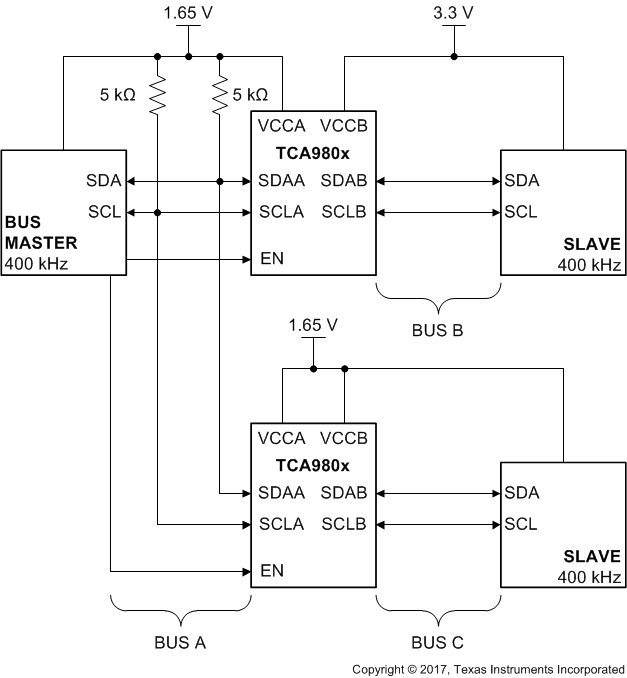SCPS266B March 2017 – February 2020 TCA9802
PRODUCTION DATA.
- 1 Features
- 2 Applications
- 3 Description
- 4 Revision History
- 5 Device Comparison Table
- 6 Pin Configuration and Functions
- 7 Specifications
- 8 Parameter Measurement Information
-
9 Detailed Description
- 9.1 Overview
- 9.2 Functional Block Diagram
- 9.3
Feature Description
- 9.3.1 Integrated Current Source
- 9.3.2 Ultra-Low Power Consumption
- 9.3.3 No Static-Voltage Offset
- 9.3.4 Active-High Repeater Enable Input
- 9.3.5 Powered Off High Impedance I2C Bus Pins on A-Side
- 9.3.6 Powered-Off Back-Power Protection for I2C Bus Pins
- 9.3.7 Clock Stretching and Multiple Master Arbitration Support
- 9.4 Device Functional Modes
- 10Application and Implementation
- 11Power Supply Recommendations
- 12Layout
- 13Device and Documentation Support
- 14Mechanical, Packaging, and Orderable Information
10.2.3 Parallel Device Use Case
The TCA980x family supports multiple TCA980x used in parallel. The A-sides of the TCA980x are allowed to be connected together.
It is critical to note that there are no external sources of current allowed on the B-side ports, since this can affect device operation shown in the IEXT-I section.
NOTE: B-sides of TCA980x devices may never be connected to each other, because the IEXT-I specification limit is violated. See the IEXT-I section for more information.
NOTE: The B-side may not be connected to another translator if it uses a static-voltage offset. The RILC spec is violated since the static voltage offset adjusts the output resistance to ground to be outside of the RILC spec requirement, causing the TCA980x to be unable to recognize a low.
 Figure 31. Parallel Use Case
Figure 31. Parallel Use Case NOTE
Decoupling capacitors are not shown to keep the illustration simple. Decoupling capacitors (1 µF and 0.1 µF) must be placed close to each power supply pin.